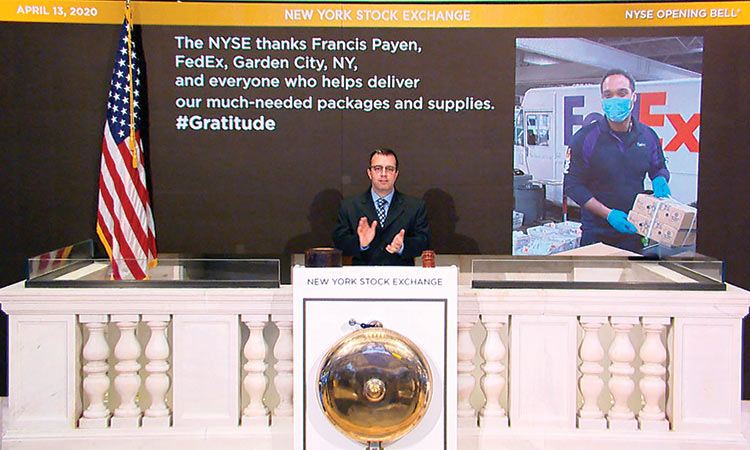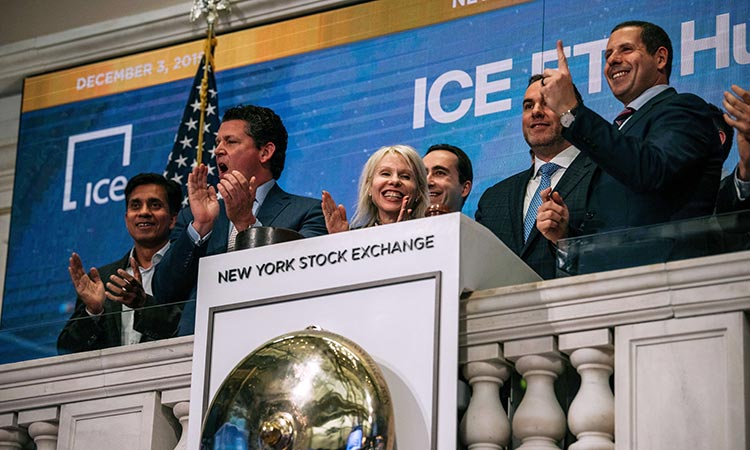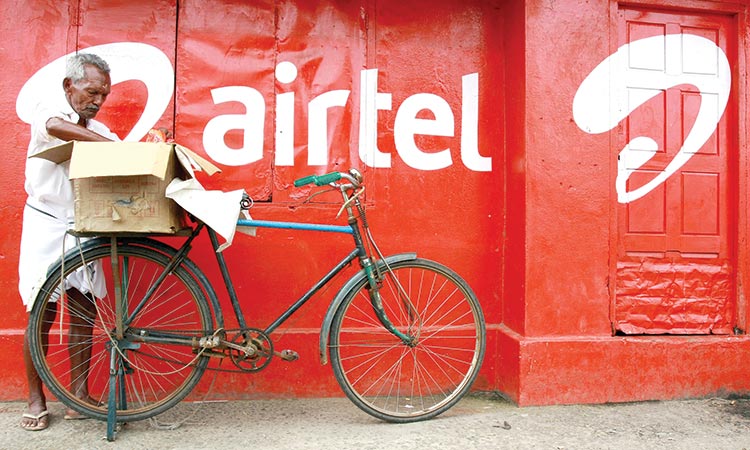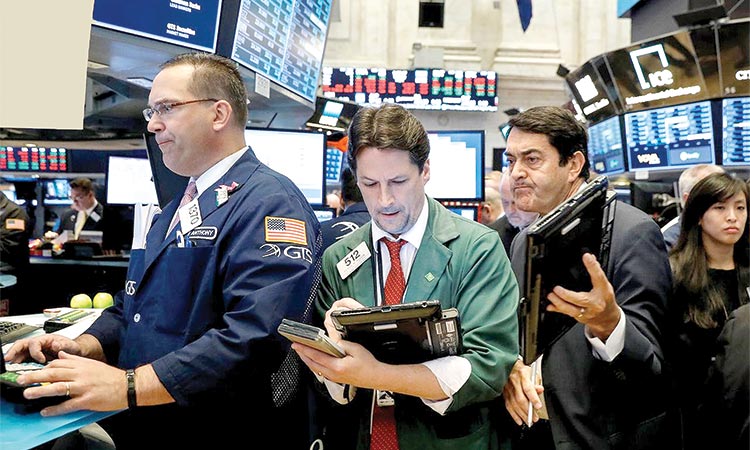Wall Street tumbles as investors brace for painful earnings data

On behalf of The New York Stock Exchange, Robert Glorioso, Chief of Building Engineering Operations, rings The Opening Bell on Monday in New York, to thank Francis Payen of Garden City, who helps deliver the much-needed packages and supplies with FedEx. Associated Press
JPMorgan Chase & Co and Wells Fargo & Co will kick off the reporting season on Tuesday, with analysts expecting an uptick in trading revenue to be offset by declines in other businesses and a bleak outlook for the rest of 2020.
The S&P banking subsector shed 2.5%, while the broader financial sector dragged on the benchmark S&P 500 with a 2.4% fall.
Overall, earnings for S&P 500 firms are expected to tumble 9.0% in the first quarter, compared with a Jan. 1 forecast of a 6.3% rise, before plummeting 20.7% in the second quarter as sweeping lockdowns halt business activity and spark furloughs.
“We’re bracing for one of the worst earnings seasons in recent history,” said Jesse Cohen, senior analyst at financial markets platform Investing.com.
The S&P 500 has recovered about 26% since hitting a three-year low in March, powered by aggressive US monetary and fiscal stimulus and early signs of a potential peaking in US coronavirus cases, but remains about 18% below its mid-February record high amid fears of a deep global recession.
“The raft of stimulus from the Federal Reserve has distorted stock prices, which have become disconnected from fundamentals. Combined with the bleak second-quarter data expected to come this month, there is definitely room for more downside,” Cohen said. US jobless claims topped a staggering 16 million in the three weeks to April 4 and economists expect job losses of up to 20 million this month, as entire sectors shut down to try and contain the pandemic.
The outbreak could reach its US peak this week, a top health official said on Monday, as the White House considers when and how to lift stay-at-home restrictions.
“It’s becoming clear that reaching the virus crescendo does not automatically translate into a timeline for when an economy will re-open,” said Marios Hadjikyriacos, investment analyst at online broker XM in Cyprus.
At 10:08am, the Dow Jones Industrial Average was down 295.12 points, or 1.24%, at 23,424.25, the S&P 500 was down 31.30 points, or 1.12%, at 2,758.52 and the Nasdaq Composite was down 35.15 points, or 0.43%, at 8,118.42.
Energy stocks gained 1.4% following a record oil output cut..
Dish Network Corp shed 3.5% as it announced layoffs and said it was re-evaluating its business to cope better with the fallout from the coronavirus outbreak.
Ford Motor Co fell 3.7% after the carmaker projected quarterly adjusted loss before interest and taxes to be about $600 million, compared with a profit of $2.4 billion a year earlier.
Declining issues outnumbered advancers more than 3-to-1 on the NYSE and 2-to-1 on the Nasdaq.
The S&P index recorded two new 52-week highs and no new low, while the Nasdaq recorded seven new highs and four new lows.
Meanwhile, gold prices edged higher to hit a more than one-month peak on Monday, on concerns about the global economic damage from the coronavirus outbreak and support measures from central banks worldwide. Spot gold was up 0.3% at $1,694.50 per ounce by 10:47am, having earlier hit its highest since March 9 at $1,697.75. US gold futures fell 0.6% to $1,742.90.
“There was a bit of profit taking early on, but prices should remain firm. Central banks are doing everything in their power to support the stock market and economy, which will eventually lead to inflation,” said Phil Streible, chief market strategist at Blue Line Futures in Chicago.
“Yields on debt instruments are virtually zero, which increases physical demand for gold and silver as a safe-haven asset.” Inflation is regarded as gold-positive, because bullion is seen as a safe store of value when price pressures are rising. The US Federal Reserve on Thursday announced a broad, $2.3 trillion stimulus package to help weather the outbreak. The crisis has forced 16.8 million Americans to file for unemployment benefits since the week ended March 21. European Union finance ministers agreed on Thursday on half-a-trillion euros worth of support for their coronavirus-battered economies but left open the question of how to finance recovery in the bloc, which is headed for a steep recession. The pandemic has infected more than 1.8 million people worldwide and killed 113,849, forcing countries to extend lockdowns and central banks to announce support measures to mitigate the financial toll. US stock indexes fell at the open with investors bracing for an expected slide in quarterly earnings and signs of the long-term damage of the outbreak on Corporate America.
“COVID-19’s deflationary effect has been a headwind for gold. But this trend should reverse in 2H20 as policy responses by governments and central banks gather traction,” UBS analysts said in a note. “Led by Fed easing, we now expect real US interest rates to dip deeper into negative territory and perhaps even test the post-GFC (global financial crisis) lows,” UBS said. Lower interest rates also reduce the opportunity cost of holding non-yielding bullion. Indicative of sentiment, holdings in SPDR Gold Trust, the world’s largest gold-backed exchange-traded fund, rose 0.6% to 994.19 tonnes on Thursday.
Agencies







